In a recent interview with a writer for the Reader’s Digest, she asked me about the meaning of Easter. I told her that Easter means hope, quoting my own writing on Easter (Wong, 2002):
“Easter never fails us. Even in the worst of times, amidst destruction, death and despair, Easter arrives as surely as daybreak, boldly proclaiming the message of renewal and hope. Whether you believe in the historical truth of the resurrection of Jesus Christ or in its symbolism, Biblical accounts of the first Easter Sunday have proven to be a powerful source of inspiration and transformation.”
Easter is only a few days away. Easter reminds us of the paradoxical truth that the crown comes after the cross and rebirth comes after death. We need to keep Easter in mind in order to say “Yes” to life in spite of the horrors of suffering and meaninglessness of human existence.
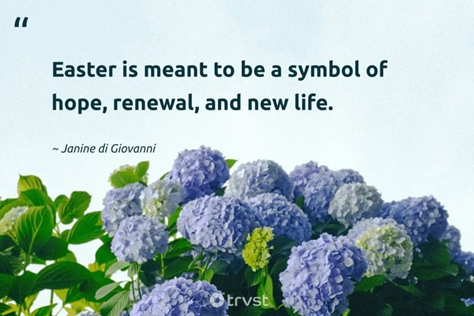
Introduction
I have been to hell and back twice. That is how I learned to say “Yes” to life even at the bottom of the dark pit of suffering and death.
My first close encounter with death was due to the severe side effects of being prescribed the wrong medication (Wong, 2008). I recorded my lived experience of going through the crucible of suffering which eventually led to a publication on mature happiness (Wong & Bowers, 2018),
My second close encounter with death was February last year. It was caused by my dentist’s negligence of giving me antibiotics for the extraction of one of my molar teeth. Within three days, the resulting infection and inflammation landed me at Toronto’s Mount Sinai Hospital’s emergency ward.
After three hours of surgery, excruciating pain and burning sensations of itchiness tormented my recuperation at Mount Sinai. In addition, my long and sleepless nights were haunted by scary hallucinations. There was no escape from my living hell. What sustained me during those lonely and painful days and nights at Mount Sinai was my faith-based hope (Wong, 2023).
Now, after more than a year, I am still processing the deeper meaning of my struggles at Mount Sinai Hospital. I am still wrestling with God about so many questions: What is the point of striving towards my noble vision when I am already old and struggling with many pains and obstacles? How can I experience joy and meaning in the face of futility, absurdity, and the horrors of human evil?
My only consolation is that I am not alone in my existential crisis. Many people much more intelligent and successful than me–e.g., Tolstoy, Nietzsche, and Frankl–have gone through similar existential struggles. Some of my readers may be also going through existential crises and agonizing over such questions such as giving up or holding on to hope.
In this brief paper, I want to share some of my reflections and discoveries. I hope that these thoughts may give you the courage and faith to say “Yes” to life no matter what.
The Four Major Sources of Help and Hope for Affirming Life
There are at least four major sources of help and hope in our existential struggles:
1. Medicine and Science
Most people pin their hope on medical doctors, but they are also fallible human beings like you and me, as I have just described in the Introduction. Elsewhere, I have also listed many reasons why we need to go beyond the medical model to find answers to the problems of human sufferings and predicaments (Wong & Laird, 2023).
Yes, science and technology have their limitations. As Jean-Paul Sartre famously said, “Everything has been figured out, except how to live.” Indeed, science and technology solve most problems in the physical world, but it still cannot heal our broken hearts and liberate us from human bondage.
The good news is that, even with their inherent human limitations, medical and health science continue to make breakthroughs to save lives and reduce mental illness. For example, delivering weak electrical currents through electrodes placed on the forehead can reduce depression (Fox, 2024), and science can prolong life and increase life expectancy (Yanes, 2023).
But the value of human life is not measured by how long you live, but by how well you live. My research on successful aging has shown the importance of meaning and spirituality in improving wellbeing during old age (Wong, 1989, 1998). Thus, it would be difficult to go through life without some personal meaning and religious faith.
2. Religion and Faith
According to research, religious faith is another major source of wellbeing for practicing believers (Cranney, 2024); they tend to be happier and healthier than the unbelievers. But religion is also a double-edged sword (Pargament & Lomax, 2013); in spite of its health benefits, it also contributes to conflicts, violence, and even mental illness.
In addition, there is evidence that faith and religion cannot always protect believers from mental illness and suicide (Lawrence et al, 2016; Therapy for Christians, 2021). For example, one Chrisian pastor reported three suicides in his church within two years (Widmer, 2023).
My personal experience as a pastor and a psychologist is that there is an important difference between shallow and deep religiosity. For the former, believers tend to be dogmatic, close-minded, hypocritical, and judgemental of those belonging to a different religion. They emphasize rituals rather than living out their faith. Many of the downsides of religiosity can be attributed to the shallow variety.
In contrast, people that exhibit deep religiosity emphasize a nuanced understanding of the scripture, authenticity in beliefs, and living out their faith everyday, whether at home or in church. They love God with all their heart, mind, and soul. They can give a reason for their beliefs and people know that they are believers by their love for others. C. S. Lewis, Henry Nouwen, and Thomas Merton are just some of the examples of deep Christianity.
For myself, I eventually found Christ through the long journey of growing up with traditional Chinese culture (Buddhism, Confucianism, and Taoism), searching for consolation and truth in existentialism and Christianity during my youth, and my final discovering that the heart and soul of Christianity is faith in Christ crucified and raised from death for my salvation.
This long and tortuous journey allows me to have the breadth and depth of deep religiosity. I have found the only truth capable of defeating the horrors of suffering and death: only God himself is capable of coming up with the utterly insane way of saving us from sin and death–by sending his son Jesus to die for us in order to redeem us from the penalty of sin (John 3:16). At the deepest level, Christ is also universal because the divine truth of faith, hope, and love (Wong, 2023) can be found in all major religions.
3. Philosophy and Philosophical Therapy
Philosophy, as the study of wisdom, has a lot to offer about both the pursuit of happiness and the reduction of suffering and suicide. It is not surprising that more and more philosophers are practicing philosophical counselling (Romeo, 2023).
There are different philosophical schools such as Stoicism, Existentialism, and Taoism. There are also difference philosophical perspective on suicide (Kelly & Dale, 2011). Regardless of which school of philosophy, they all agree on the importance of rationality, knowledge, wisdom, truth, and morality. They help people develop a philosophy of life regarding their worldviews, core beliefs, and most cherished values. It is always beneficial to know one’s true self, what really matters, and examine one’s own life so that one may gain wisdom for living.
For example, Kierkegaard, known as the father of existential philosophy, wrote: “One must first learn to know oneself before knowing anything else. Only when the person has inwardly understood himself, and then seen the way forward on his path, does his life acquire repose and meaning.” Another influential existential philosopher, Nietzsche, wrote in Beyond Good and Evil (1886/2010):
I want to learn more and more to see as beautiful what is necessary in things; then I shall be one of those who make things beautiful. Amor fati: Let that be my love henceforth! I do not want to wage war against what is ugly. I do not want to accuse; I don’t even want to accuse those who accuse. Looking away shall be my only negation. And all in all… I wish to be only a Yes-sayer.
Contrary to public understanding, Nietzsche is not a nihilist. One of his main struggles is to overcome the horrors of existence and nihilism. The above quotes clearly indicate that, after all his emotional and intellectual struggles, he chose to love fate (Amor fati), say “Yes” to life, and affirm the possibility of joy (Chang, 2024).
In order to live without regrets for all his mistakes and accept the horrors of suffering and meaninglessness, Nietzsche resorted to the will to power and develop the myth of becoming a “superman” according to his book, Thus Spoke Zarathustra (Cybulska, 2012; Nietzsche, 1885/1954). He proposes that we need to resort to creating myths and illusions in order to survive the horrors and terrors of human existence. That is how we can maintain some sanity in an insane society. This created “truth” allows us to love our destiny and do something great with our lives in the midst of chaos and uncertainty. His solution is similar to the terror management theory in psychology (Solomon et al, 1991) and Soper’s (2020) brain-pain theory of suicide.
4. Psychology and Psychotherapy
As a psychologist, I naturally believe that psychology is a major source of healing and wellbeing. Like philosophy, there are different schools of psychology, such as psychoanalysis, behaviorism, humanism, and multiculturalism. They all contribute to a holistic understanding of what it means to a human being. There are also major schools of psychotherapy, such as existential therapy, cognitive behavioural therapy (CBT), narrative therapy, acceptance and commitment therapy, and integrative therapy.
After doing research and therapy in so many schools of psychology and psychotherapy, I finally came to the conclusion that since people are so complex and multifaceted and mental illness still remains a mystery, the only sensible thing to do is to take a holistic and integrative approach.
My integrative framework for research is called “existential positive psychology” (PP 2.0) because the science of positive psychology of wellbeing and flourishing needs to be situated in the larger context of human existence with its dark and bright side of life. We can be healed and made whole through the dialectical interaction between Yin (dark) and Yang (bright), with an emphasis on transcending polarity and transforming suffering to inner peace, balance, and harmony (Wong & Bowers, 2018; Wong & Cowden, 2022). Therefore, do not seek to maximize your happiness and success; be content with optimizing your inner peace with yourself, others, and God.
My integrative meaning therapy was shaped by Nietzsche, Maslow, and Frankl. It incorporates various therapeutic modalities, such as CBT, narrative therapy, existential therapy, and cross-cultural therapy, with meaning as the central organizing construct. Not only do we need to make every minute meaningful, but also need to devote our lives to something much greater and nobler than ourselves. It is a life of self-transcendence.
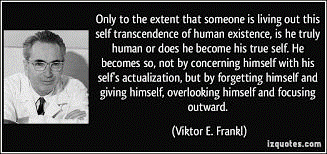
Viktor Frankl’s concept of self-transcendence represents a paradigm shift which simultaneously restore the human soul and spirituality to the center stage of psychology and elevates the human quest for meaning as the most important primary motivation capable of healing and flourishing in the face of suffering and death, as represented by the following figure:
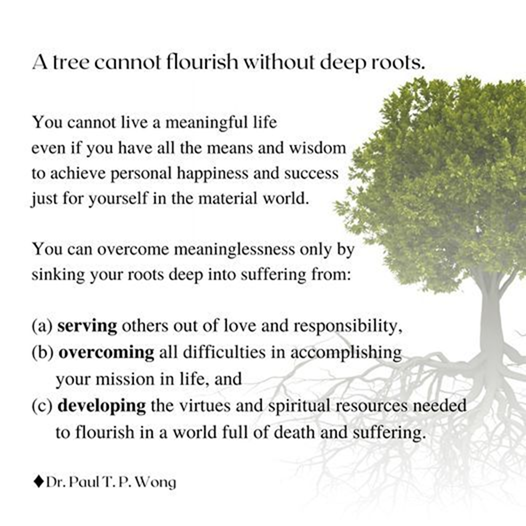
If you are languishing or struggling with suffering and meaninglessness, the following principles of PP 2.0 may be helpful to you:
- Awareness of your true self: The process of knowing your true self is fraught with challenges. Not only do you need to have the courage to face your dark side, but you also need to work through various kinds of self-deception and defense mechanisms. It is a worthwhile endeavour because to embrace and love the totality of yourself is the foundation of mental health. In his book On Becoming a Person, Carl Rogers (1961/1995) says: “The curious paradox is that when I accept myself just as I am, then I change.” Positive transformation begins with facing and accepting the rejected parts of yourself.
- The duality of suffering and happiness: Everything exists in duality in a fallen world. Thus, good and evil, as well as happiness and suffering, coexist. However, one can achieve non-duality through awakening, rebirth, and self-transcendence. The last process involves transcending the duality through the daily spiritual discipline of mindfulness meditation and wrestling with God in order to achieve inner peace, balance, and harmony.
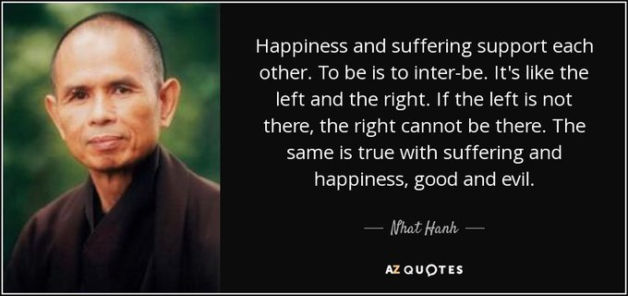
- The principles of self-transcendence (Wong, 2022) are shown in the next graph. Meditate on them. Any of these principles can show you a path to move forward but your need to cultivate your existential courage, faith, hope, and love.
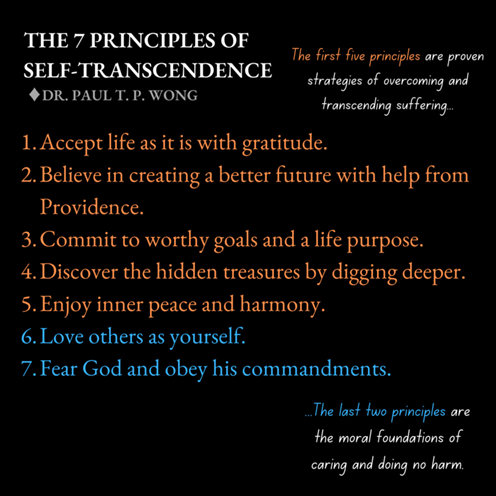
Conclusion
In the light of the truth of Easter and Good Friday, I can boldly say “Yes” to life whatever the circumstances. Only divine truth is greater than the reality of suffering and death and more powerful than any of the superhero myths.
You can also start with the baby steps of developing new life attitudes and new habits according to the above lesson and the principles according to the following graph. In the final analysis, your character determines your wellbeing and your destiny. Therefore, love your fate, and love your life.

Before I sign off, I want to recommend to you two remarkable books: 1) Viktor Frankl’s Man’s Search for Meaning, and 2) Laura Hillenbrand’s (2010) bestselling book Unbroken: A World War II Story of Survival, Resilience, and Redemption–a biopic of Louis (Lourie) Zamperini’s struggle for survival after a plane crash until his liberation from a prisoner of war camp.
These two books have one thing in common. When the protagonists were subjected to unimaginable horrors of sufferings and degradation, they drew their inner strength from the defiant power of the human spirit and faith in God as the Ultimate Rescuer. Both books illustrate the truth that you need to embrace the faith and spirituality in you in order to survive and transcend the horrors of life.
“I have told you these things, so that in me you may have peace. In this world you will have trouble. But take heart! I have overcome the world” (John 16:33). May the power of the only true superhero be with you, now and forever!
If you are interested in learning more about integrative meaning therapy (IMT), please register for my upcoming certificate course here. More details can be found here.
References
Chang, E. C. (2024). An appraisal of Nietzsche’s philosophical concept of amor fati: A potentially useful psychological construct in the study of positive human existence? The Humanistic Psychologist. https://doi.org/10.1037/hum0000354
Cranney, S. (2024, March 23). Are religious people happier? The science is pretty clear. Deseret News. https://www.deseret.com/opinion/2024/03/23/religion-effect-on-happiness/
Cybulska, E. (2012). Nietzsche’s Übermensch: A hero of our time? Philosophy Now. https://philosophynow.org/issues/93/Nietzsches_Ubermensch_A_Hero_of_Our_Time
Fox, N. (2024, March 25). ‘The headset helps my depression so I can be a dad again. BBC. https://www.bbc.com/news/uk-england-northamptonshire-68567726
Frankl, V. E. (1985). Man’s search for meaning. Washington Square Press. (First published in 1946)
Hillenbrand, L. (2014). Unbroken: A World War II story of survival, resilience, and redemption. Random House.
Kelly, C., & Dale, E. (2011). Ethical perspectives on suicide and suicide prevention. Advances in Psychiatric Treatment, 17(3), 214–219. https://doi.org/10.1192/apt.bp.109.007021
Lawrence, R. E., Oquendo, M. A., & Stanley, B. (2016). Religion and suicide risk: A systematic review. Archives of suicide research: Official journal of the International Academy for Suicide Research, 20(1), 1–21.
Nietzsche, F. (1954). Thus spoke Zarathustra. (W. Kaufmann, Trans.). The Viking Press. (Original work published in 1885)
Nietzsche, F. (2010). Beyond good and evil. CreateSpace Independent Publishing Platform. (Originally published in 1886)
Pargament, K. I., & Lomax, J. W. (2013). Understanding and addressing religion among people with mental illness. World psychiatry: Official journal of the World Psychiatric Association (WPA), 12(1), 26–32. https://doi.org/10.1002/wps.20005
Rogers, C. R. (1995). On becoming a person: A therapist’s view of psychotherapy (2nd ed.). HarperOne. (Originally published in 1961)
Romeo, N. (2023, December 23). When philosophers become therapists. The New Yorker. https://www.newyorker.com/culture/annals-of-inquiry/when-philosophers-become-therapists
Soper, C. A. (2020). The evolution of life worth living: Why we choose to live. C. A. Soper.
Solomon, S., Greenberg, J.,& Pyszczynski, T. (1991). A terror management theory of social behavior: The psychological functions of self-esteem and cultural worldviews. Advances in Experimental Social Psychology, 24, 93–159. https://doi.org/10.1016/S0065-2601(08)60328-7
Widmer, C. (2023, September 27). Our church lost three men to suicide in two years. Christianity Today. https://www.christianitytoday.com/ct/2023/september-web-only/suicide-stats-christian-church-community-pastor-resources.html
Williams, C. (2021, June 1). Does faith prevent mental health issues? Therapy for Christians. https://www.therapyforchristians.com/blog/mental-illness-and-faith
Wong, P. T. P. (1989). Personal meaning and successful aging. Canadian Psychology, 30(3), 516–525. https://doi.org/10.1037/h0079829/
Wong, P. T. P. (1998). Spirituality, meaning, and successful aging. In P. T. P. Wong & P. S. Fry (Eds.), The human quest for meaning: A handbook of psychological research and clinical applications (pp. 359–394). Lawrence Erlbaum Associates Publishers.
Wong, P. T. P. (2002). The meaning of Easter: A message for positive psychology. Positive Living Newsletter. https://www.meaning.ca/archives/presidents_columns/pres_col_apl_2002_meaning-of-easter.htm
Wong, P. T. P. (2008). To hell and back and what I have learned about happiness. International Network on Personal Meaning.
https://www.meaning.ca/archives/archive/art_hell_and_back_P_Wong.html
Wong, P. T. P. (2022). The best possible life in a troubled world: The seven principles of self-transcendence [亂世中活出最好的人生:自我超越的七項原則]. Positive Psychology in Counseling and Education. https://doi.org/10.30099/PPCE.202206_(1).0001
Wong, P. T. P. (2023). Spiritual-existential wellbeing (SEW): The faith-hope-love model of mental health and total wellbeing. International Journal of Existential Positive Psychology, 12(1). https://www.meaning.ca/ijepp-article/vol12-no1/spiritual-existential-wellbeing/
Wong, P. T. P., & Bowers, V. (2018). Mature happiness and global wellbeing in difficult times. In N. R. Silton (Ed.), Scientific concepts behind happiness, kindness, and empathy in contemporary society. IGI Global.
Wong, P. T. P., & Cowden, R. G. (2022). Accelerating the science and practice of psychology beyond WEIRD biases: Enriching the landscape through Asian psychology. Frontiers in Psychology. https://doi.org/10.3389/fpsyg.2022.1054519
Wong, P. T. P., & Laird, D. (2023). Varieties of suffering in clinical settings: Re-envisioning mental health beyond the medical model. Frontiers in Psychology, 14. https://doi.org/10.3389/fpsyg.2023.1155845
Yanes, J. (2023, February 16). Can science extend the human lifespan? BBVA Open Mind. https://www.bbvaopenmind.com/en/science/bioscience/can-science-longevity-human-lifespan/

 Meaning Conference 2025 will be the INPM’s first in-person conference with a virtual option after the pandemic.
Meaning Conference 2025 will be the INPM’s first in-person conference with a virtual option after the pandemic.